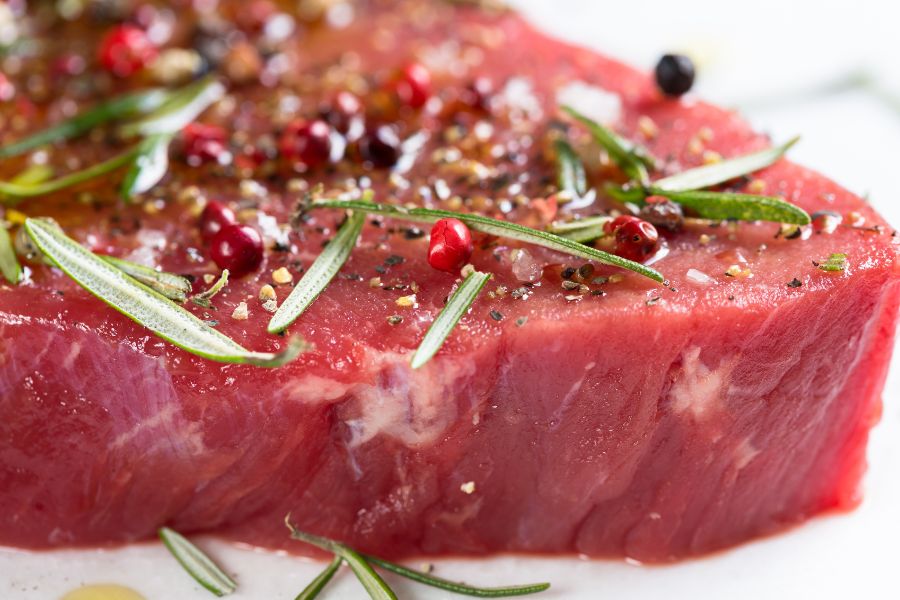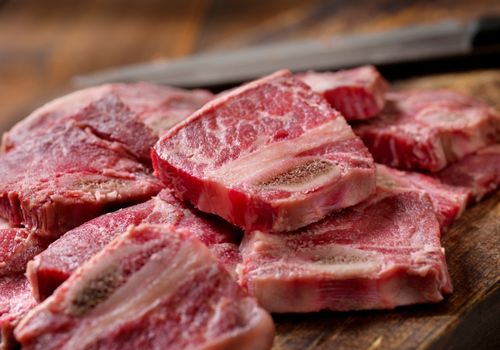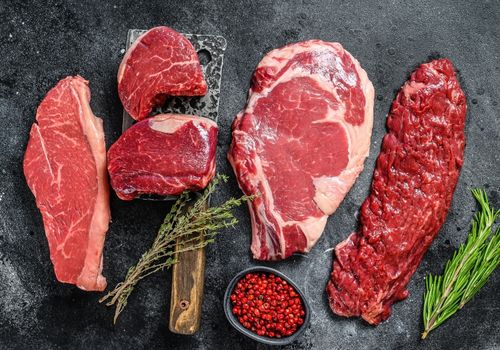Most of us cooks agree that 1.5 inches is the ideal steak thickness. But anyone who imagines the “perfect” steak often sees a piece of meat in front of them that – according to their own description – should certainly be “neither too thick nor too thin.”
What does that actually mean exactly? How thick can (or rather should) a steak be? Are there guidelines? And why is the right thickness actually so important in general? In this article, I’ve got all your answers. Bear in mind, the perfectly cooked steak doesn’t end at the thickness.

My recommended steak thickness is 1.5 inches. This is the borderline between a thick and thin steak. So that’s the average and ideal thickness. Thicker steak cuts can, however, measure up to two inches thick. Meanwhile, when we’re talking about extra thick steaks, they can be 3-inches thick. Extra thick steaks like this will, however, need a longer method of cooking.
While cooking extra thick steak cuts, you can have the steak cooked using the 2-2-1 grilling method or cook on direct heat zone and then finish in an indirect zone. An extremely thick steak cut can also be cooked using a reverse sear method. Then after the reverse sear technique, it is finished in the oven.
Steak thickness isn’t just a portion issue. Without a sufficiently thick steak, the contrast between the outside and inside that is desired is difficult to achieve. Thinner steaks tend to overcook before they can develop a nice tasty crust.
I try to get steaks that are at least an inch thick. That means each steak weighs between 250 and 550 grams – that’s a lot, even for someone with a big red meat appetite. But remember, it’s better to grill one large steak for two than two small steaks.
When the steak is sliced too small, you lose a lot of juice to the fire. A larger steak is always juicier and tender. Of course, the cooking time is often a bit longer and you’ll need a grill that contains it, and the proper cooking method.
Related Reading
Thinner steaks cook through quickly when frying in a pan or on the grill. There is little leeway for precise doneness.
Therefore, buy a piece of meat from the butcher that is about 1 to 2 inches thick. For your steak to get a crispy crust and remain light pink (medium rare doneness) on the inside, it simply has to be a little thicker.
It is, therefore, better to buy a fillet mignon or tenderloin steak and share it with your guests instead of serving everyone a thin rag.
Cooks who like thin steaks (one-inch thickness or less) run the risk of the meat tasting dry or tough. Or, to put it another way: the full potential of this special dish cannot be exploited in this way.
Also, extreme heat will easily spoil your recipe when cooking thin steaks, unlike extra thick cuts. Also, you will destroy high-quality beef by cutting it too thin.
However, this is what thinner steak fans have always held on to. If you like to cook your steak medium or even medium rare, the exterior of the steak tends to get burnt before the core reaches the desired doneness. Very thin steak cuts cook quick, even without bark on.
The guideline here is a height of about three fingers (considering a finger is about half an inch).
Furthermore, based on this thickness, the steak cut should weigh at least 250 grams or half a pound. This results (at least as a rule) not only in a satiating effect but also in a visually appealing cut.
With thicker steaks (around 1.5-inch to 2-inch thick steak cuts), it is much easier to create a juicier steak with a full-bodied taste when frying. In short: the proper thickness of the meat can contribute to culinary enjoyment.

If you have bought meat of the appropriate thickness, you have created the basic conditions for enjoying a juicy steak. But:
The thickness is not the only decisive factor in ensuring that the steak ends up perfect.
Of course, the right preparation also plays an important role in this context. As a rule of thumb, the steak should only be placed in the pan when it has reached around 350 degrees Fahrenheit.
It is far better to wait until a light crust or bark has formed on the back than turning the meat over and over again. Your steak only needs to be turned over and heated from the other side once.
If both sides have been fried accordingly and provided with said crust, the steak can be finished up in the preheated oven.
Related Reading
The quality of the meat is decisive for the taste experience. Of course, a high-quality beef costs much more than a shrink-wrapped piece from the discounted sale.
How the animals are kept, fed, and aged is just as decisive for the higher quality and the associated higher price as the breed and maturity.
Producing top meat from the best raw material takes time, money, and a lot of work.
On the other hand, there is the intensive/factory animal farming, which produces large quantities quickly. But what you get is cheap meat!
The focus usually is on meeting the market demands and less on raising animals ethically, ecologically, and to the taste of the consumers.
Although the pieces are inexpensive, they also deliver a quality that is sometimes unreasonable. Let alone species-appropriate animal husbandry.
It’s like the difference between a Ferrari and a Trabbi. One contains the best materials, research, time, and craftsmanship. The other one has… er… cardboard.
It’s the same with meat. In contrast to a really good piece of steak, the supermarket product simply tastes like cardboard.
That’s why it’s better to invest once and be happy than to constantly skimp and live unhappily (even if you didn’t know it before).
If you don’t have a good butcher in your area or really want to try a special steak, look on the internet. There are some large and trustworthy online retailers, such as Kansas City Steak Company, Snake River Farms, Omaha Steaks, and the Chicago Steak Company, who send shrink-wrapped and chilled premium cuts to your home by mail.
Unfortunately, it has always been a trend to breed cattle to be as lean as possible. Fat marbling is great especially if you can afford high-quality steaks with higher content of monosaturated fat like Angus or Wagyu beef.
When we think of fat on meat, we think of fat on the hips, cholesterol, and bursting arteries. At the meat counter, you will find very few cuts marbled with thick rind of fat on top. It’s all cut away cleanly. But fat gives flavor.
Therefore always buy meat with marbling (intermuscular fat). Why is that important? When frying or cooking, it melts and becomes soft, making your steak tender and juicy. Fat marbling protects the steak from becoming dry and developing a disappointing taste.

Your rib eye steak should be aged on the bone for four weeks and be an inch or two thick. The rib eye steak is a thick steak. It differs from naturally thin cuts like the fillet mignon on T-bone steak or flank steaks. It is a thick steak with a characteristic eye of fat. It should be cut at least 1 inch thick and weigh between a half pound and 1.2 pounds (250 and 550 grams).
Sirloin steaks are not particularly thick steaks. They are tender and thin, usually cut to be less than 2 inches. But I think 1.5-inch thick cuts the sweet spot for sirloin steaks. It’s the perfect cut for pan searing, grilling, or broiling.
Related Reading
Surely anyone who has eaten a steak that’s too thin in the past knows how underwhelming it is. To put it simply: juicy meat needs a little space at the top to develop its full aroma.
Anyone who has been annoyed that their homemade steak tastes “somehow tough” and was unable to discover anything unusual in the cut type, cooking temperature, or seasoning is advised to check the thickness of the meat.
If you want the steak to be particularly tender or juicy, ensure that it has a thickness or meat height of 1.5 inches or up to three fingers.